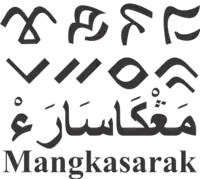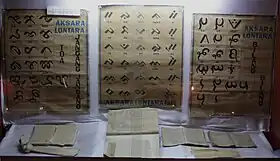| Makasar | |
|---|---|
| Bahasa Makassar | |
| ᨅᨔ ᨆᨀᨔᨑ Basa Mangkasaraʼ | |
 | |
| Native to | Indonesia |
| Region | South Sulawesi (Sulawesi) |
| Ethnicity | Makassarese |
Native speakers | 2.1 million (2000 census)[1] |
| Dialects |
|
| Lontara (present) Latin (present) Serang (Makassar Annals, religious purpose) Old Makassarese (historical) | |
| Language codes | |
| ISO 639-2 | mak |
| ISO 639-3 | mak |
| Glottolog | maka1311 |
Makassarese (basa Mangkasaraʼ or basa Mangkasarak), sometimes called Makasar, Makassar, or Macassar, is a language of the Makassarese people, spoken in South Sulawesi province of Indonesia. It is a member of the South Sulawesi group of the Austronesian language family, and thus closely related to, among others, Buginese.
Phonology
The following description of Makassarese phonology is based on Jukes (2005).[2]
Vowels
Makassarese has five vowels: /a/, /e/, /i/, /o/, /u/. The mid vowels are lowered to [ɛ] and [ɔ] in absolute final position and in the vowel sequences /ea/ and /oa/.
Consonants
| Labial | Alveolar | Palatal | Velar | Glottal | ||
|---|---|---|---|---|---|---|
| Nasal | m | n | ɲ | ŋ | ||
| Plosive | voiceless | p | t | c | k | ʔ |
| voiced | b | d | ɟ | ɡ | ||
| Fricative | s | h | ||||
| Semivowel | j | w | ||||
| Lateral | l | |||||
| Trill | r | |||||
Makassarese consonants except the glottal stop can be geminated. Some instances of these might result from Proto-Malayo-Polynesian schwa phoneme *ə (now merged into a), which left gemination into the following consonant (*bəli → *bəlli → balli "to buy, price", compare Indonesian beli, contrasting with Makassarese bali "to oppose").[3]
- /ɲ/ is written ⟨ny⟩ before a vowel, ⟨n⟩ before ⟨c⟩ and ⟨j⟩
- /ŋ/ is written ⟨ng⟩
- /ɟ/ is written ⟨j⟩
- /j/ is written ⟨y⟩
- /h/ only occurs in loanwords
- The glottal stop /ʔ/ only occurs in syllable-final position. It is written as ⟨k⟩ in the orthography promoted as the standard by the government and based on the practice in Indonesian, as an apostrophe ⟨ʼ⟩ in other orthographic standards, sometimes as ⟨q⟩ in academical writing, or not written at all in informal writing.
Phonotactics
All consonants except for /ʔ/ can appear in initial position. In final position, only /ŋ/ and /ʔ/ are found.
Consonant clusters only occur medially and (with one exception) can be analyzed as clusters of /ŋ/ or /ʔ/ + consonant. These clusters also arise through sandhi across morpheme boundaries.
| nasal/lateral | voiceless obstruents | voiced stops + r | |||||||||||||
|---|---|---|---|---|---|---|---|---|---|---|---|---|---|---|---|
| m | n | ɲ | ŋ | l | p | t | c | k | s | b | d | ɟ | ɡ | r | |
| /ŋ/ | mm | nn | ɲɲ | ŋŋ | ll | mp | nt | ɲc | ŋk | ns | mb | nd | ɲɟ | ŋg | nr |
| /ʔ/ | ʔm | ʔn | ʔɲ | ʔŋ | ʔl | pp | tt | cc | kk | ss | ʔb | ʔd | ʔɟ | ʔg | ʔr |
The geminate cluster /rr/ is only found in root-internal position and cannot be accounted for by the above rules.
Sequences of like vowels are contracted to a single vowel, e.g. sassa 'to wash' + -ang 'nominalizing suffix' > sassáng 'laundry', caʼdi 'small' + -i 'third person' > caʼdi 'it is small'.
Current writing systems
Although Makassarese is now often written in Latin script, it is still widely written using Lontara script, which once was used also to write important documents in Bugis and Mandar, two related languages from Sulawesi.

Examples
Some common words/phrases in the Makasar language, transcribed in the Latin script, are as follows (ʼ = glottal stop):
| Lontara | Romanized | Indonesian | Translation |
|---|---|---|---|
| ᨈᨕᨘ | tau | orang | people |
| ᨄᨎᨗᨀᨗ | paʼnyiki | kelelawar | bat |
| ᨕᨑᨙ | areng | nama | name |
| ᨕᨊ | anaʼ | anak | child |
| ᨔᨙᨑᨙ᨞ ᨑᨘᨓ᨞ ᨈᨒᨘ᨞ ᨕᨄ᨞ ᨒᨗᨆ᨞ | seʼre, rua, tallu, appaʼ, lima | satu, dua, tiga, empat, lima | one, two, three, four, five |
| ᨅᨕᨗᨊᨙ | baine | perempuan, istri | female, woman, wife |
| ᨅᨘᨑᨊᨙ | buraʼne | lelaki, suami | male, man, husband |
| ᨈᨅᨙ | tabeʼ | permisi, maaf | excuse me, sorry |
| ᨈᨕᨙᨊ, ᨈᨙᨊ, ᨈᨑᨙ | taena, tena, tanreʼ | tiada | none, nothing |
| ᨒᨙᨅ | leʼbaʼ | telah | already |
| ᨔᨒᨆᨀᨗ ᨅᨈᨘ ᨆᨕᨙ | salamakkiʼ battu mae | selamat datang | welcome |
| ᨕᨄ ᨕᨈᨘ ᨆᨕᨙ ᨀᨅᨑ? | apa antu mae kabaraʼ? | apa kabar? | how are you? |
| ᨅᨍᨗᨅᨍᨗᨍᨗ | bajiʼ-bajiʼji | baik-baik saja | I am fine |
| ᨊᨕᨗ ᨕᨑᨙᨊᨘ? | nai arenta? | siapa namamu? | what's your name? |
| ᨒᨀᨙᨑᨙᨀᨗ ᨆᨕᨙ? ᨒᨀᨙᨀᨗ ᨆᨕᨙ? ᨒᨀᨙᨆᨕᨗᨀᨗ? |
lakereki mae?, lakekimae?, lakemaeki? |
kamu mau ke mana? | where are you going? |
| ᨀᨙᨑᨙ ᨆᨕᨙᨀᨗ ᨕᨆᨈ | kere maekiʼ ammantang? | kamu tinggal di mana? | where do you live? |
| ᨔᨗᨐᨄᨆᨗ ᨕᨘᨆᨘᨑᨘᨈ? | siapami umuruʼta? | berapa usiamu? | how old are you? |
| ᨔᨒᨆᨀᨗ ᨑᨗ ᨆᨂᨙᨕᨈᨙ | salamakkiʼ ri mangeanta | selamat sampai tujuan | have a safe trip |
| ᨔᨒᨆᨀᨗ ᨑᨗ ᨒᨄᨈ | salamakkiʼ ri lampanta | selamat tinggal | goodbye |
| ᨅᨈᨘ ᨑᨗ ᨀᨈᨙ | battu ri katte | tergantung padamu | it depends on you |
Historical writing systems


Makassarese was historically written using Makasar script (also known as "Old Makassarese" or "Makassarese bird script" in English-language scholarly works).[4] In Makassarese the script is known as ukiriʼ jangang-jangang or huruf jangang-jangang ('bird letters'). It was used for official purposes in the kingdoms of Makasar in the 17th century but ceased to be used by the 19th century, being replaced by Lontara script.
In spite of their quite distinctive appearance, both the Makasar and Lontara scripts are derived from the ancient Brahmi script of India. Like other descendants of that script, each consonant has an inherent vowel "a", which is not marked. Other vowels can be indicated by adding diacritics above, below, or on either side of each consonant.
Further, Makassarese was written in the Serang script, a variant of the Arabic-derived Jawi script. Texts written in the Serang script are relatively rare, and mostly appear in connection with Islam-related topics. Parts of the Makassar Annals, the chronicles of the Gowa and Tallo' kingdoms, were also written using the Serang script.[3]
See also
Further reading
- Tabain, Marija and Jukes, Anthony (2016). "Makasar". Illustrations of the IPA. Journal of the International Phonetic Association. 46 (1): 111–99. doi:10.1017/S002510031500033X
{{cite journal}}: CS1 maint: multiple names: authors list (link), with supplementary sound recordings.
References
- ↑ Makasar at Ethnologue (18th ed., 2015) (subscription required)
- ↑ Jukes, Anthony, "Makassar" in K. Alexander Adelaar & Nikolaus Himmelmann, 2005, The Austronesian languages of Asia and Madagascar, pp. 649-682, London, Routledge ISBN 0-7007-1286-0
- 1 2 Jukes, Anthony (2020). A Grammar of Makasar: A Language of South Sulawesi, Indonesia. Leiden & Boston: BRILL. ISBN 978-90-04-41266-8.
- ↑ Pandey, Anshuman (2015-11-02). "L2/15-233: Proposal to encode the Makasar script in Unicode" (PDF).